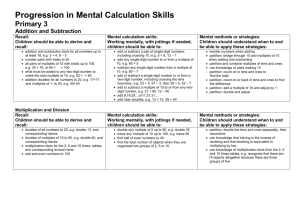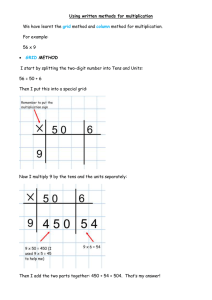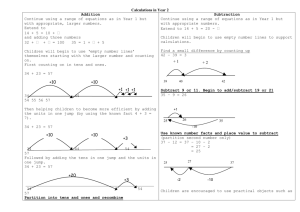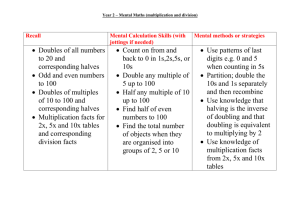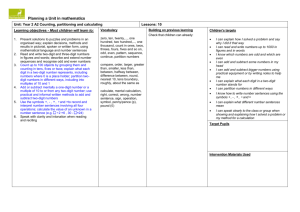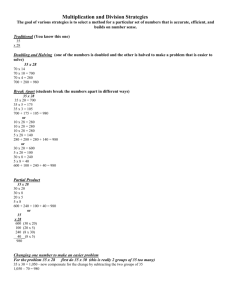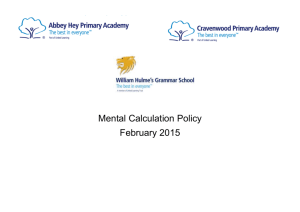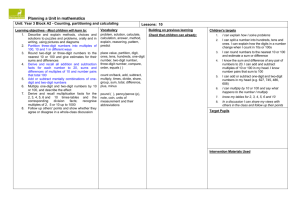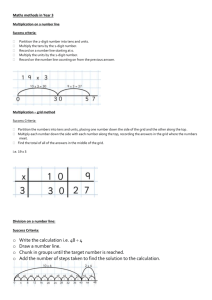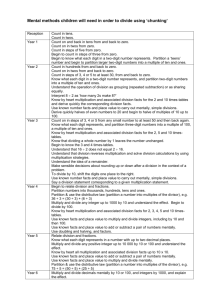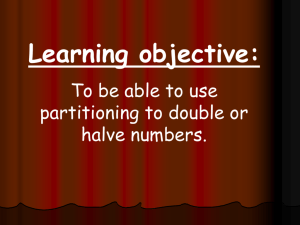Progression in Mental Calculation Skills Primary 5 Addition and
advertisement
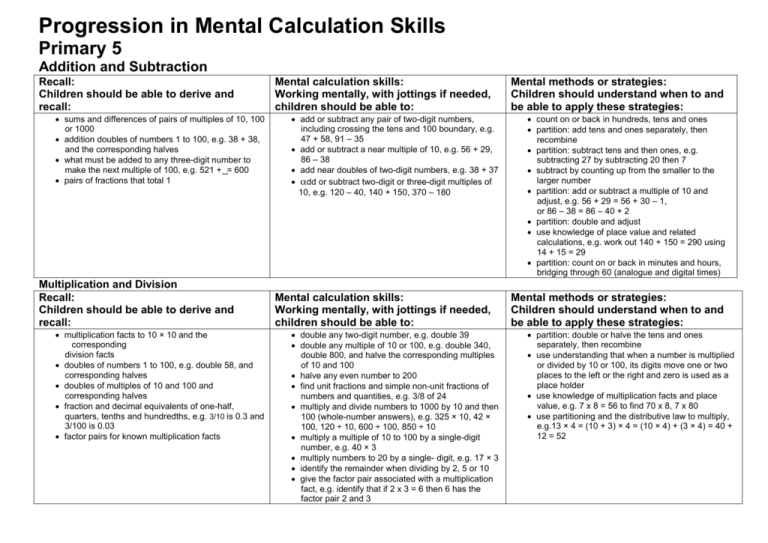
Progression in Mental Calculation Skills Primary 5 Addition and Subtraction Recall: Children should be able to derive and recall: sums and differences of pairs of multiples of 10, 100 or 1000 addition doubles of numbers 1 to 100, e.g. 38 + 38, and the corresponding halves what must be added to any three-digit number to make the next multiple of 100, e.g. 521 +␣= 600 pairs of fractions that total 1 Multiplication and Division Recall: Children should be able to derive and recall: multiplication facts to 10 × 10 and the corresponding division facts doubles of numbers 1 to 100, e.g. double 58, and corresponding halves doubles of multiples of 10 and 100 and corresponding halves fraction and decimal equivalents of one-half, quarters, tenths and hundredths, e.g. 3/10 is 0.3 and 3/100 is 0.03 factor pairs for known multiplication facts Mental calculation skills: Working mentally, with jottings if needed, children should be able to: add or subtract any pair of two-digit numbers, including crossing the tens and 100 boundary, e.g. 47 + 58, 91 – 35 add or subtract a near multiple of 10, e.g. 56 + 29, 86 – 38 add near doubles of two-digit numbers, e.g. 38 + 37 dd or subtract two-digit or three-digit multiples of 10, e.g. 120 – 40, 140 + 150, 370 – 180 Mental calculation skills: Working mentally, with jottings if needed, children should be able to: double any two-digit number, e.g. double 39 double any multiple of 10 or 100, e.g. double 340, double 800, and halve the corresponding multiples of 10 and 100 halve any even number to 200 find unit fractions and simple non-unit fractions of numbers and quantities, e.g. 3/8 of 24 multiply and divide numbers to 1000 by 10 and then 100 (whole-number answers), e.g. 325 × 10, 42 × 100, 120 ÷ 10, 600 ÷ 100, 850 ÷ 10 multiply a multiple of 10 to 100 by a single-digit number, e.g. 40 × 3 multiply numbers to 20 by a single- digit, e.g. 17 × 3 identify the remainder when dividing by 2, 5 or 10 give the factor pair associated with a multiplication fact, e.g. identify that if 2 x 3 = 6 then 6 has the factor pair 2 and 3 Mental methods or strategies: Children should understand when to and be able to apply these strategies: count on or back in hundreds, tens and ones partition: add tens and ones separately, then recombine partition: subtract tens and then ones, e.g. subtracting 27 by subtracting 20 then 7 subtract by counting up from the smaller to the larger number partition: add or subtract a multiple of 10 and adjust, e.g. 56 + 29 = 56 + 30 – 1, or 86 – 38 = 86 – 40 + 2 partition: double and adjust use knowledge of place value and related calculations, e.g. work out 140 + 150 = 290 using 14 + 15 = 29 partition: count on or back in minutes and hours, bridging through 60 (analogue and digital times) Mental methods or strategies: Children should understand when to and be able to apply these strategies: partition: double or halve the tens and ones separately, then recombine use understanding that when a number is multiplied or divided by 10 or 100, its digits move one or two places to the left or the right and zero is used as a place holder use knowledge of multiplication facts and place value, e.g. 7 x 8 = 56 to find 70 x 8, 7 x 80 use partitioning and the distributive law to multiply, e.g.13 × 4 = (10 + 3) × 4 = (10 × 4) + (3 × 4) = 40 + 12 = 52
